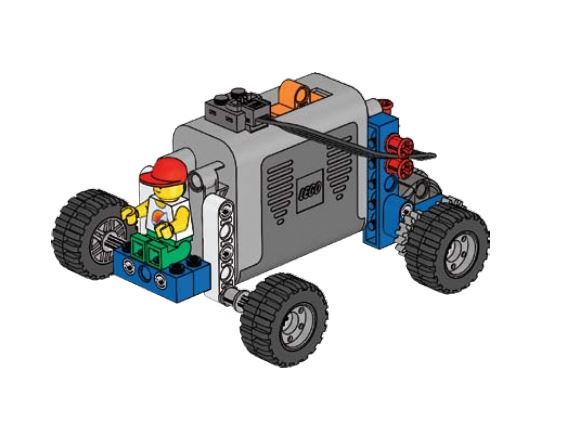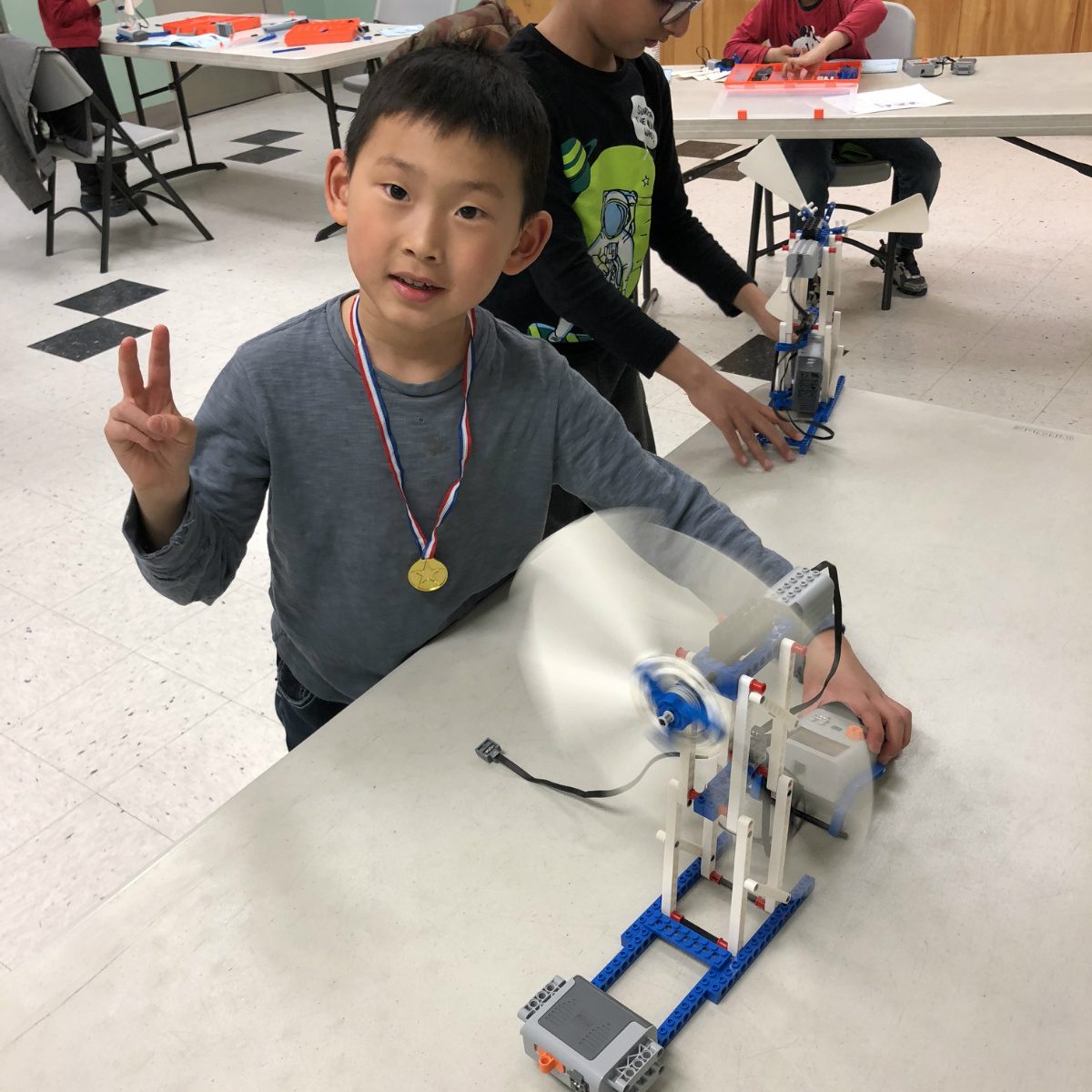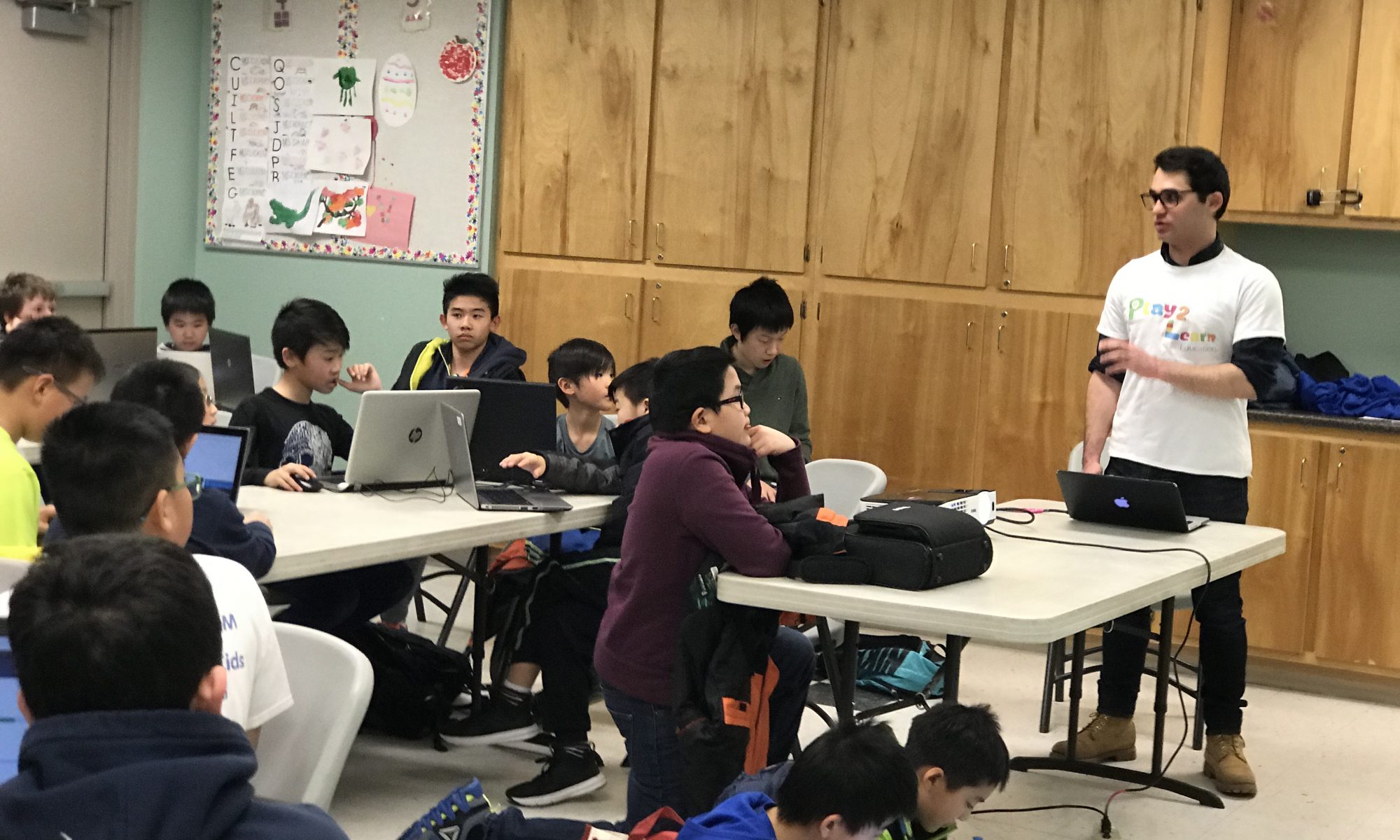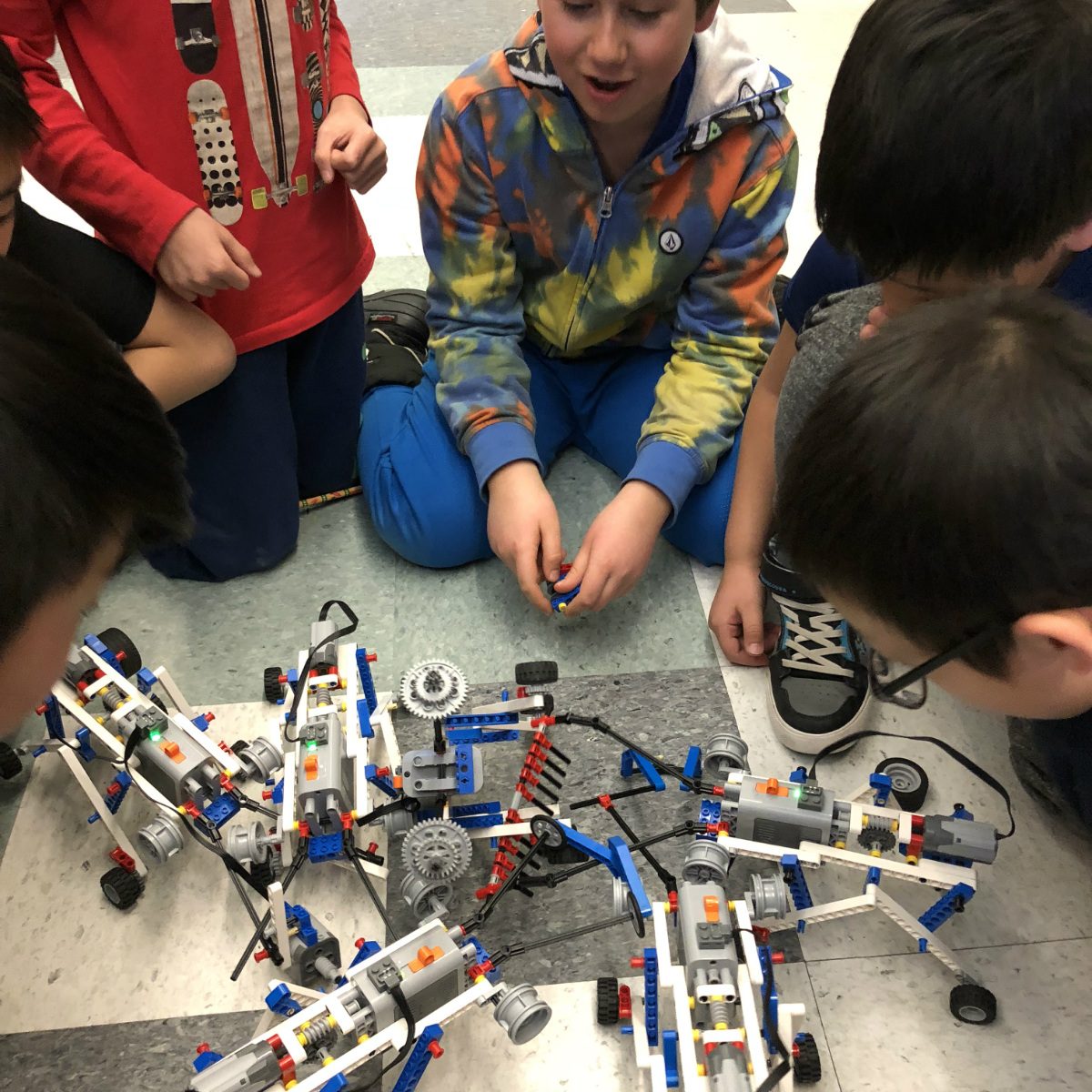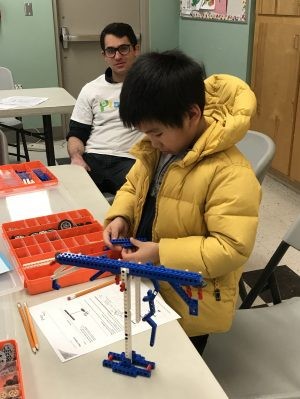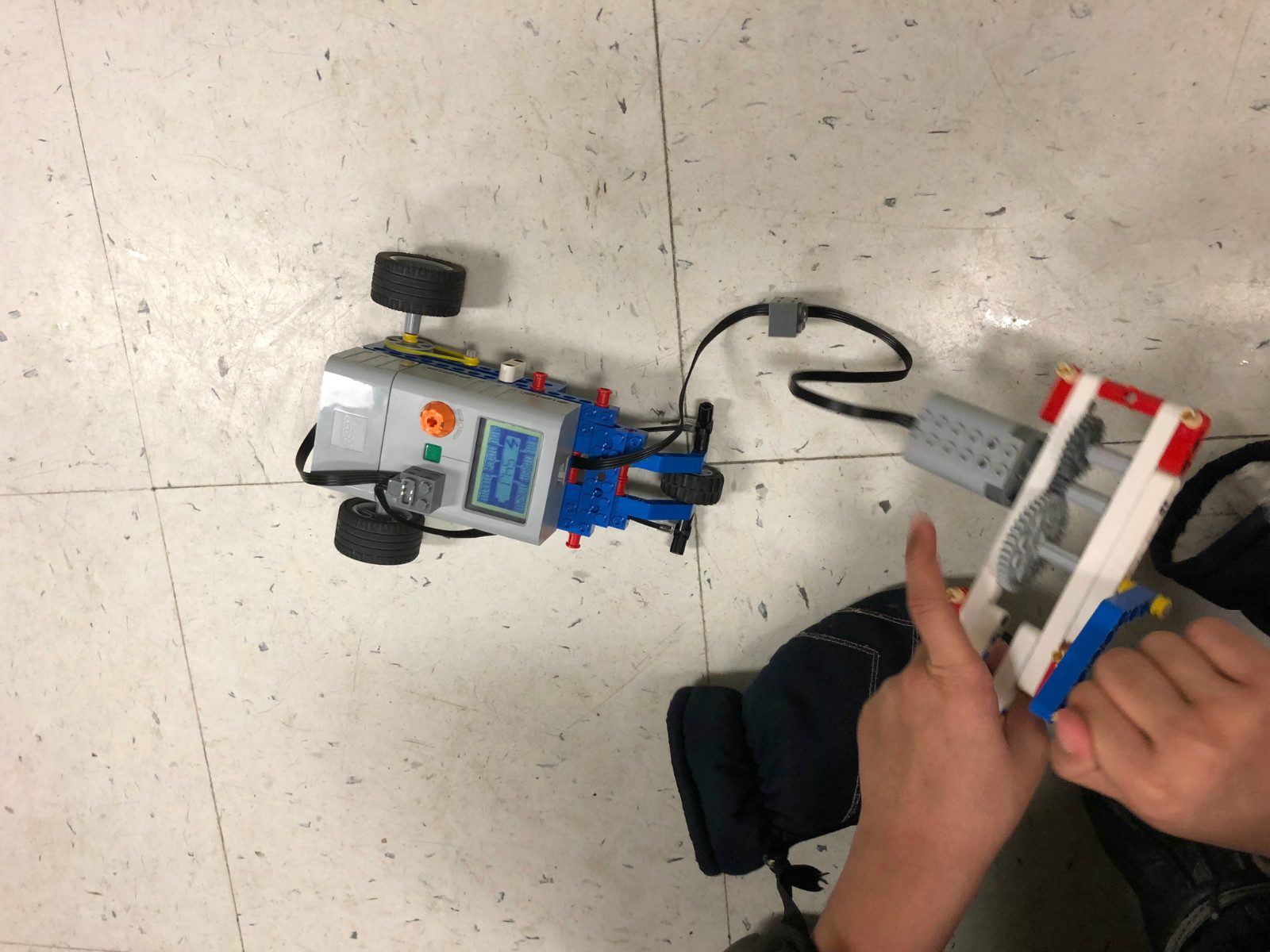In our first class we built a small battery powered car and learned a bit about gear ratios and how the size of wheels affects speed. The kids quite liked racing their cars that day.
Communication ECA Phase III Class 3: Wind Turbine 20180321
The theme of today is the wind turbine. The wind turbine model transferred the wind energy generated by a fan to electrical energy stored in the power meter. The experiment is a very good mimic to the real wind turbines used in real world. The students finished the model building part smoothly, and then they all conducted and finished the experiment. During which I explained the STEM information, which is the power equals to voltage multiplies current.
Most of the student cannot perform decimal multiplications, thus the experiments were simplified to observe and record joules instead of watt calculations. One extra part to use the generated electoral power was also added to the class, which deepened their understandings of the Power Meter usage. All students finished the experiments and filled the lab sheets. They love the challenging project.
Communication ECA Phase II Class 3: The Windmill 20180321
The topic of today is the windmill. The students built a windmill to learn the energy conversions between wild energy and rotational energy by the blade mechanism. Windmills were used to mill grain, pump water in the history, but the majority of modern windmills take the form of wind turbines used to generate electricity, or wind pumps used to pump water. In the class, we used a weight as water to mimic the pumping water process. The STEM information behind this section is the energy transformation as well as force and motion concepts.
All students finished the model and conducted tests with a different level, they enjoyed the class. The ability level of the students vary, thus it needs to arrange them wisely to make sure all of them can at least finish the model building part.
PBP Phase 1: Class 2: Power Hammer
Today we built the Power Hammer and learned about force and friction. The students seemed to have enjoyed the activity with some making incredible modifications in order to give more impact force for their hammers. To all parents please make sure that all the students arrive on time and clean up thoroughly after.
Communication ECA Phase I Class 3: The Hammer
The kids were able to do really well in the last class and also enjoyed their time. Even though some of the children did notice that this project was a little more challenging than the ones they had worked on in the previous classes, they were able to keep up their pace and finish their projects. The concepts this class focused on were force, weight, and friction. The kids got to grasp these material and practice them with their in-class assignments. Next week there won’t be any classes as the kids will want to enjoy their spring break. I look forward to seeing everyone again on April 4.
#hourofcode in Play2Learn Education
The Hour of Code is a global movement reaching tens of millions of students in 180+ countries. Anyone, anywhere can organize an Hour of Code event. No experience needed. Ages 4 to 104.
On March 14, 2018, the first #hourofcode event was lead by Mr. Amir in Play2Learn Education Edgemont Community Classroom. There were over 30 kids involved in this one hour coding activities. We can see how kids love coding and learning programming.
Communication ECA Phase III Class 2: Boat Pulley 20180314
The topic of today is the energy transformation study using the boat pulley model. The students first built a mimic boat pulley model, then they conducted the experiment to test the energy consumption for load lifting. The experiment also includes the energy efficiency calculations of load lifting for the boat pulley, which is derived using the useful energy divided by the total energy consumption. Energy efficiency is one of the most essential physical and engineering concepts. It’s the key to understand many modern industrial system designs.
The STEM behind this class is the energy transformation between the electrical and potential energy as well as the energy efficiency. The experiment involves some math that is beyond some students’ ability, thus we simplified based on their mathematical levels. All the students finished the model buildings. More importantly, they all finished the experiment section and conducted the energy efficiency calculations. They learned knowledge and enjoyed the class.
Communication ECA Phase II Class 2: The Walker 20180314
The model building of today is the Walker. The students built a big cricket (a legged robot) to learn the basic knowledge of mechanical balance and friction. The legged robot is comprised of four legs with a wheel at each end, it can walk with different leg lengths. The walk motions are power by one electrical motor. The motor axis kinetics are transferred by a worm gear, and then to the legs. The STEM information behind this section is the basic mechanical mechanism and concepts including a worm gear, static friction and geometrical balance of machines. All students finished the model and conducted tests by changing the legs’ length to compare the walking speed and balance.
The students had a lot of fun after finishing the model building and lab tests. They used their robot as battle robots to compete with each other. Even though we are still trying to teach the students more STEM, it works better if we can teach them with fun.
Communication ECA Phase I Class 2: The Balance 20180314
This class went extremely well. The kids understood the Balance and the concepts we were working with very quickly. The in-class assignments were also done with relative ease. The concepts included mass, simple dynamics, and weight shift. Next week we will be working on a new project that is going to be slightly more complex than the previous week, as the concepts are supposed to build on each other until the end of the semester.
Communication ECA Phase III Class 1: Hand Generator 20180307
Phase III is the highest level of class in Play2Learn Education Lego Challenge Program. In the next 8 weeks, different energy form transformations will be discussed including energy experiments between kinematic energy and potential energy, electrical energy and kinematic energy, heat (light) energy and electrical energy.
The class started with the explanation of the basic skills to use the power meter and motors. The class follows with building a hand generator that transfers kinematic energy to electrical energy. The kinematic energy is generated by the students’ hand. The generated energy was stored in the power meter. The class was intense because the students need to learn the principle model knowledge and finish the hand generator model building. However, after the first class, they gained a good understanding of the power meter and motors which laid a solid ground for the following classes.


